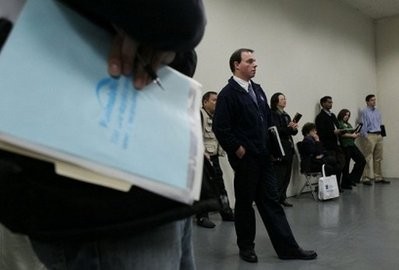The US labor market appeared to move in opposite directions in January, losing 20,000 jobs as the unemployment rate fell, but still suggests a slow return to growth, analysts say.

Friday's Labor Department report, seen as one of the best indicators of economic momentum, puzzled analysts since the two surveys used offered a vastly different picture of the critical employment sector.
The report showed the national jobless rate eased to 9.7 percent from 10.0 percent in December, based on a household survey that appeared to contradict the payrolls data.
The payrolls data meanwhile fell short of expectations for a gain of jobs that would have been a clear sign of a turnaround in the troubled labor market and overall economy after a massive stimulus effort by the government.
January's loss followed a revised loss of 150,000 jobs in December and a revised gain of 64,000 in November.
"The job market remains very tough, but headed in the right direction," said Mark Zandi, chief economist for Moody's Economy.com. "Job growth should resume this spring."
Ian Pollick, economics strategist at TD Securities, agreed, and argued that the underlying details were stronger than the headline figures.
"This was one of those reports where the 'negative' column was offset with the 'positive' column, leaving us to maintain our view that the US labor market remains on the slow path to recovery," he said.
The divergent paths for payrolls and unemployment stem from the use of two separate surveys that often provide conflicting results.
The payrolls figures, often seen as a more reliable indicator of hiring, comes from a survey of 140,000 businesses, while the jobless rate is calculated from a survey of 60,000 households.
Some analysts said the differences made it hard to interpret the data.
"The drop in the unemployment rate was particularly surprising, as it was predicated on households reporting an increase in employment," said Diane Swonk, chief economist at Mesirow Financial.
"This could be capturing the self-employed doing slightly better than they had been, but it is still puzzling."
Swonk said the economic recovery that began in mid-2009 is continuing "and we will soon reap some benefits in terms of jobs. That said, the jobs recovery is expected to remain muted and the economic recovery is still subdued."
Brookings Institution senior fellow Gary Burtless said the drop in the jobless rate was "heartening news" and "cannot be explained by a rise in the number of discouraged workers."
But Burtless added that the payroll number is the employment indicator most closely watched by investors and that "it will be seen, correctly, as one more sign of the hesitating response of employers to increased demand for US goods and services."
The January report showed a loss of 60,000 jobs in the goods-producing sector -- a hefty decline of 75,000 construction jobs offset a gain of 11,000 in manufacturing and 4,000 in mining.
The services sectors added 48,000 jobs including 42,000 in retail and 44,000 in financial activities that offset losses in other segments.
The report showed the average workweek, sometimes seen as a proxy for economic activity, rose slightly to 33.3 hours from 33.2 hours. Average hourly earnings rose 0.3 percent.
"This was a mediocre report," said Dana Johnson, chief economist at Comerica Bank.
Still, Johnson said there were encouraging signs in the data including a rise in the workweek, increased income and more temporary workers hired.
"I would be surprised if we didn't see private-sector job growth in February and March that will show a sustainable expansion. It's just not visible yet," Johnson said.
Wells Fargo economist Eugenio Aleman said the significant drop in the unemployment rate, which was better than expected, is a positive factor.
"It's a very strong drop," Aleman said.
"It's good news but I don't know if it is sustainable."
Aleman said that although the figures reflected little change in the number of people working, the drop in the jobless rate "is good for the psychological aspect of the recovery."
"This can improve consumer confidence, and maybe allow consumers to spend more" to boost overall economic activity.
























